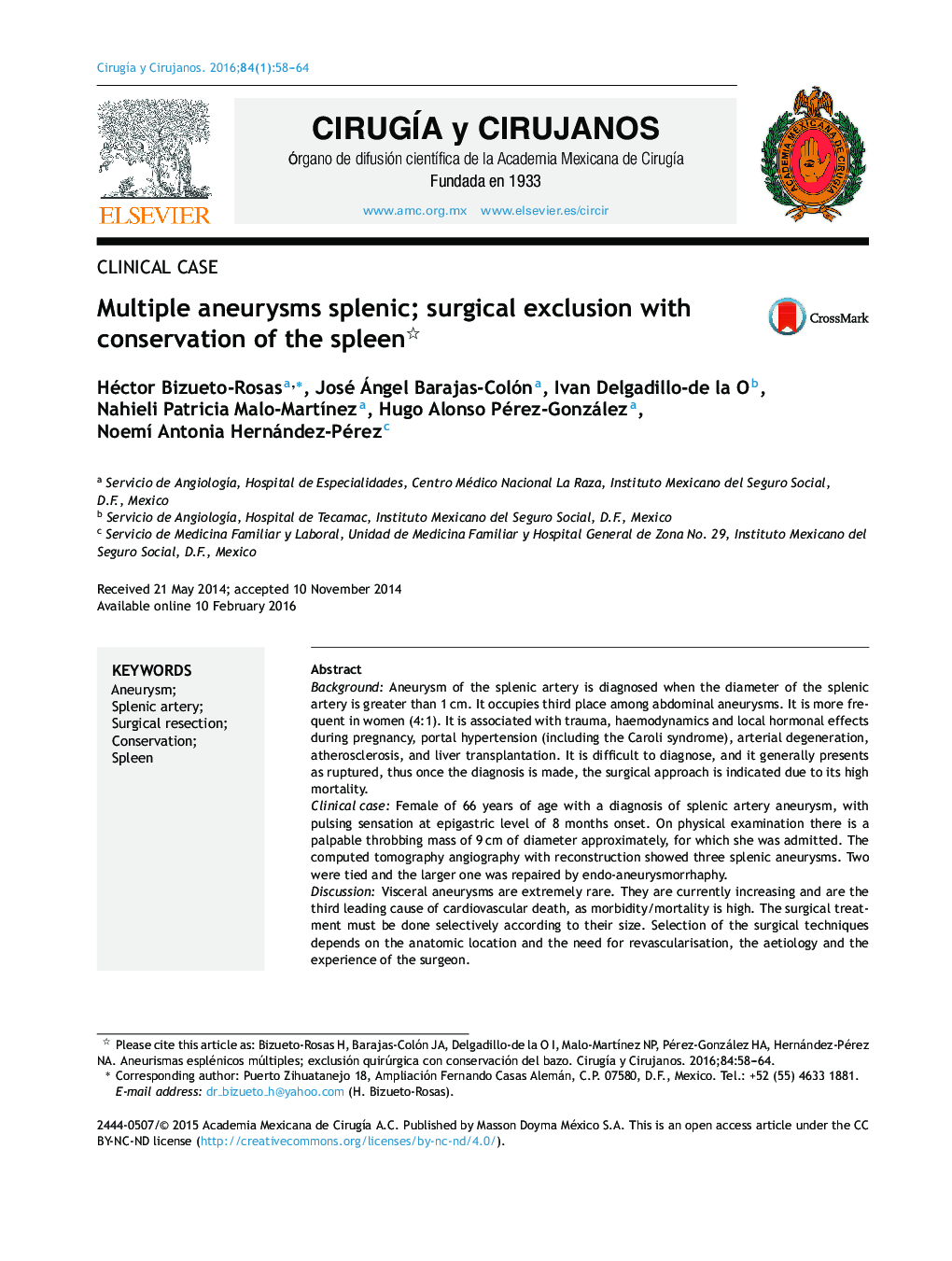| کد مقاله | کد نشریه | سال انتشار | مقاله انگلیسی | نسخه تمام متن |
|---|---|---|---|---|
| 4283391 | 1286884 | 2016 | 7 صفحه PDF | دانلود رایگان |

BackgroundAneurysm of the splenic artery is diagnosed when the diameter of the splenic artery is greater than 1 cm. It occupies third place among abdominal aneurysms. It is more frequent in women (4:1). It is associated with trauma, haemodynamics and local hormonal effects during pregnancy, portal hypertension (including the Caroli syndrome), arterial degeneration, atherosclerosis, and liver transplantation. It is difficult to diagnose, and it generally presents as ruptured, thus once the diagnosis is made, the surgical approach is indicated due to its high mortality.Clinical caseFemale of 66 years of age with a diagnosis of splenic artery aneurysm, with pulsing sensation at epigastric level of 8 months onset. On physical examination there is a palpable throbbing mass of 9 cm of diameter approximately, for which she was admitted. The computed tomography angiography with reconstruction showed three splenic aneurysms. Two were tied and the larger one was repaired by endo-aneurysmorrhaphy.DiscussionVisceral aneurysms are extremely rare. They are currently increasing and are the third leading cause of cardiovascular death, as morbidity/mortality is high. The surgical treatment must be done selectively according to their size. Selection of the surgical techniques depends on the anatomic location and the need for revascularisation, the aetiology and the experience of the surgeon.ConclusionA review has been presented on the advances in diagnostic, and management, concluding that the best is to preserve the spleen, and whatever the technique it must be performed by trained surgeons.
ResumenAntecedentesEl aneurisma de la arteria esplénica se diagnostica cuando el diámetro de la arteria esplénica es mayor de 1 cm. Ocupa el tercer lugar de los aneurismas abdominales y es más frecuente en mujeres (4:1). Etiología: traumatismo, efectos locales hormonales y hemodinámicos del embarazo, hipertensión portal (incluyendo el síndrome de Caroli), degeneración arterial, aterosclerosis y postrasplante hepático. Es de difícil diagnóstico, generalmente comienzan como rotos, por lo que una vez hecho el diagnóstico el abordaje quirúrgico está indicado por su alta mortalidad.Caso clínicoMujer de 66 años de edad con diagnóstico de aneurisma esplénico; sensación de pulsación a nivel de epigastrio de 8 meses de evolución. A la exploración física se palpa masa pulsátil de 9 cm de diámetro aproximadamente, por lo que se decide su hospitalización. La angiotomografía con reconstrucción evidencia 3 aneurismas esplénicos. Dos se ligaron y en el mayor se realizó la endoaneurismorrafia, por no poder excluirlo.DiscusiónLos aneurismas viscerales son sumamente raros; sin embargo, están actualmente aumentando, siendo la tercera causa de muerte cardiovascular. La morbimortalidad es alta y las posibilidades de supervivencia son escasas al detectarse tardíamente. Deben operarse selectivamente según su tamaño; la selección de las técnicas quirúrgicas depende: de la localización anatómica, de la necesidad de revascularización, de su etiología y, de la experiencia del cirujano.ConclusiónSe hizo una revisión de los avances diagnósticos y de manejo, concluyendo que lo mejor es preservar el bazo y cualquiera que sea la técnica, debe realizarse por cirujanos capacitados.
Journal: Cirugía y Cirujanos (English Edition) - Volume 84, Issue 1, January–February 2016, Pages 58–64